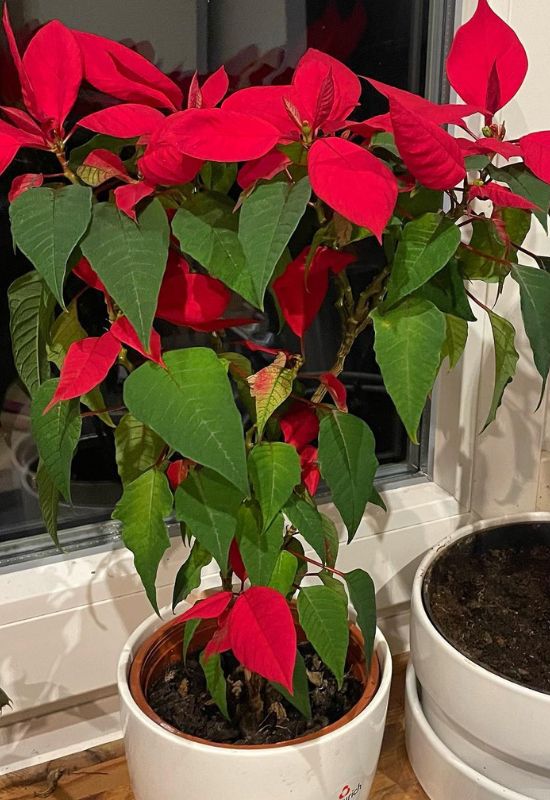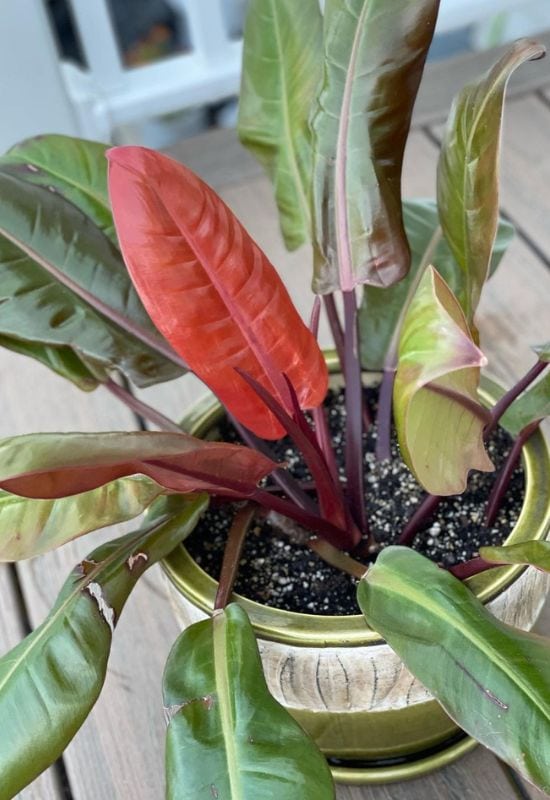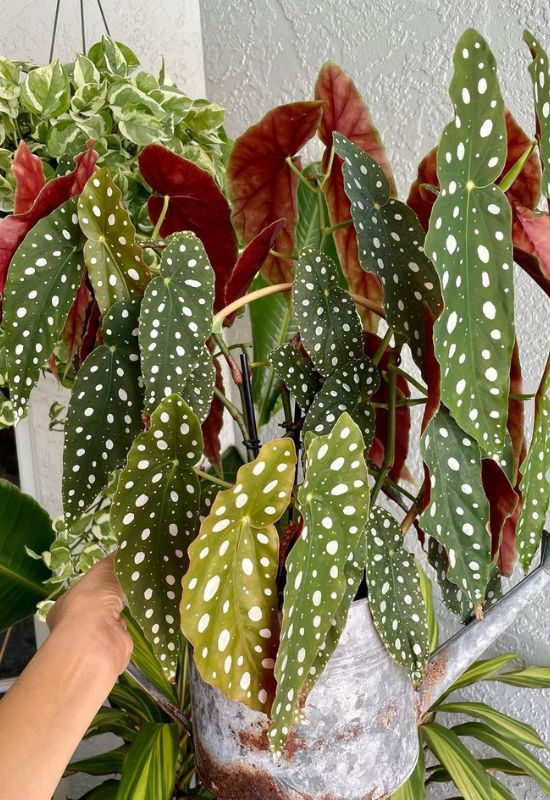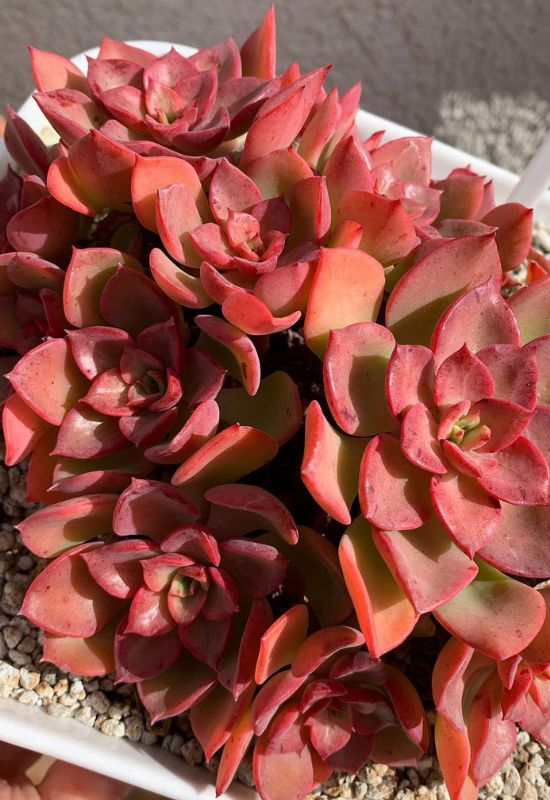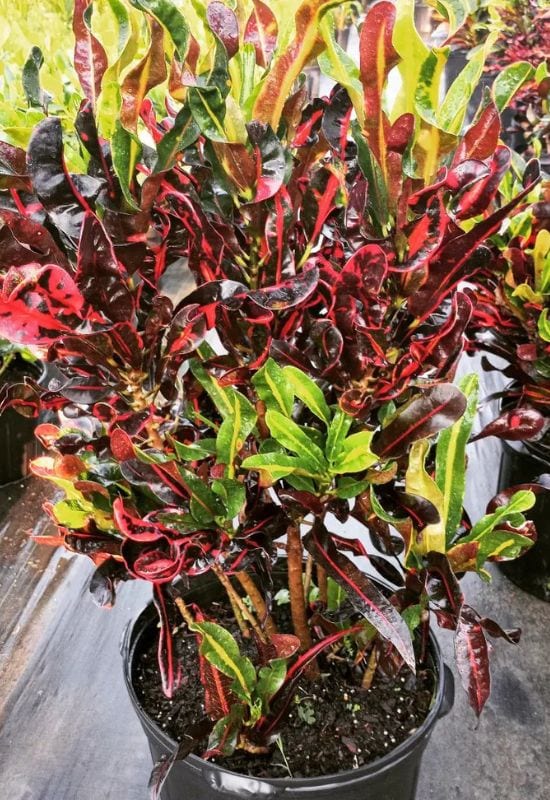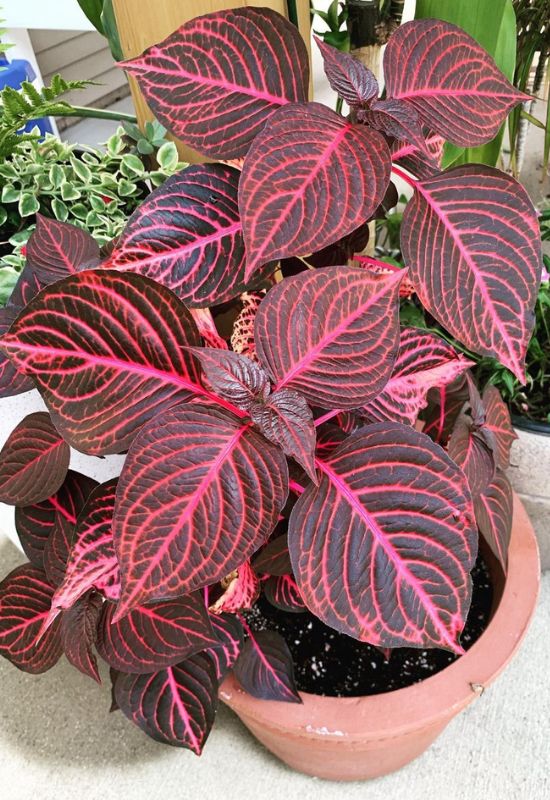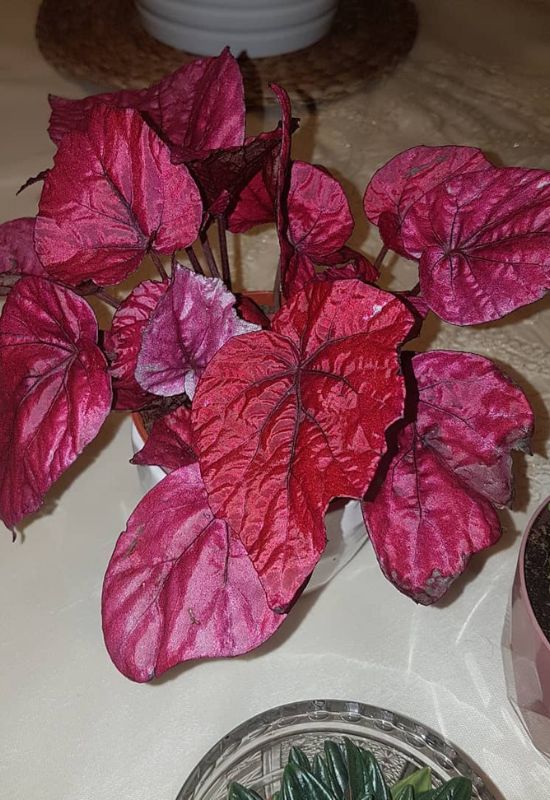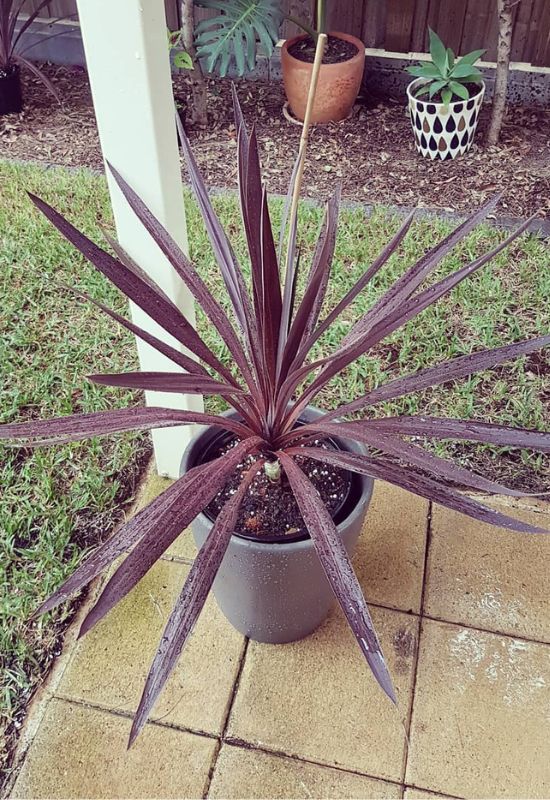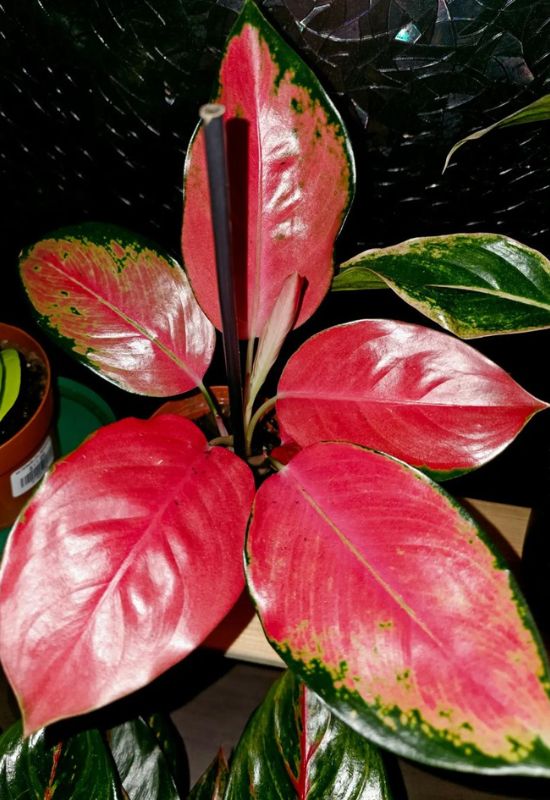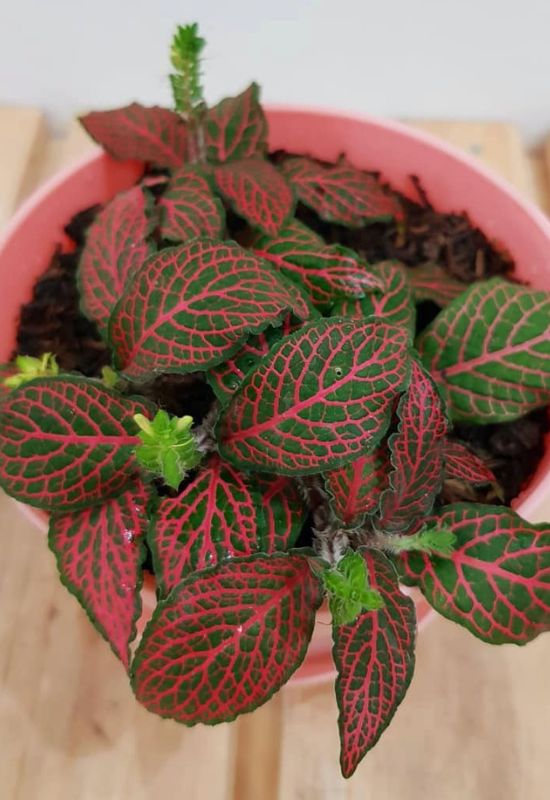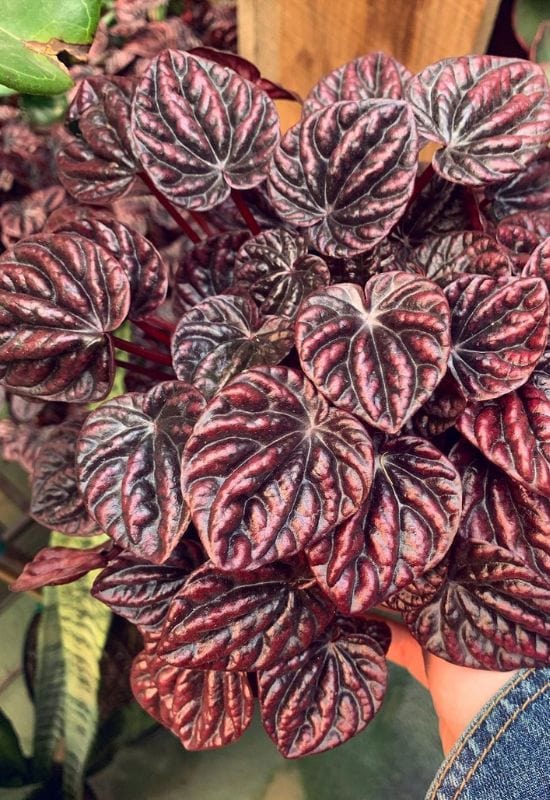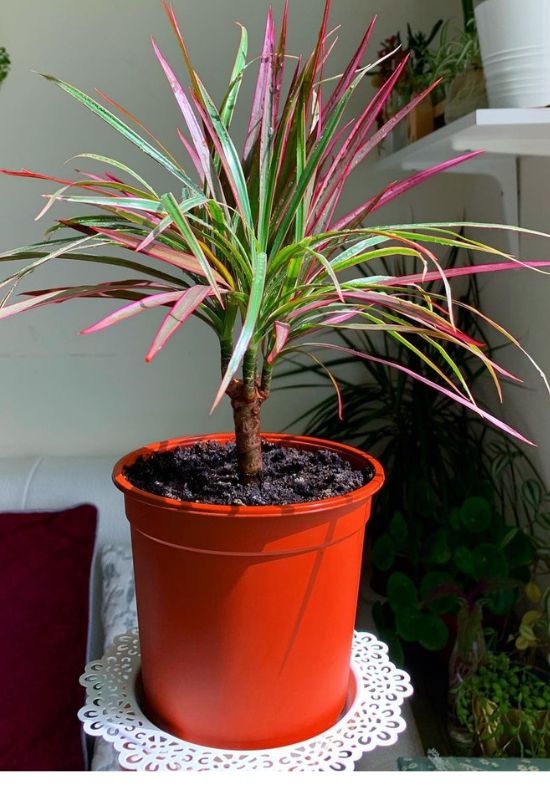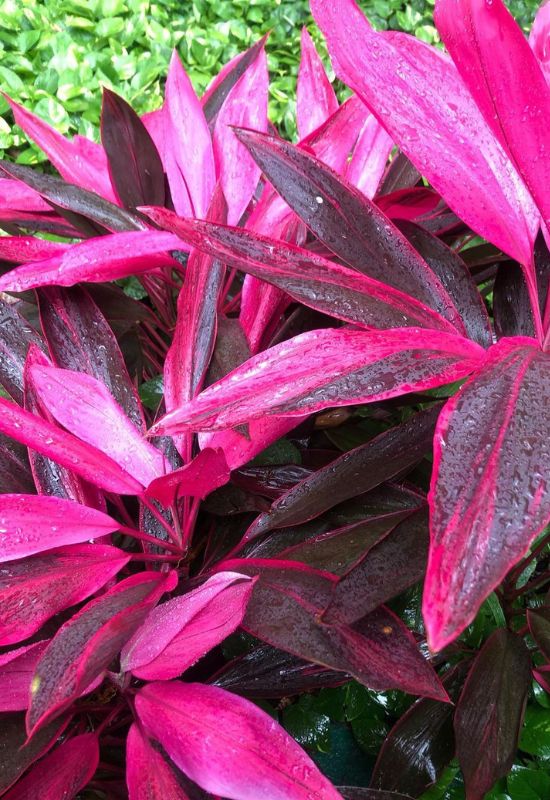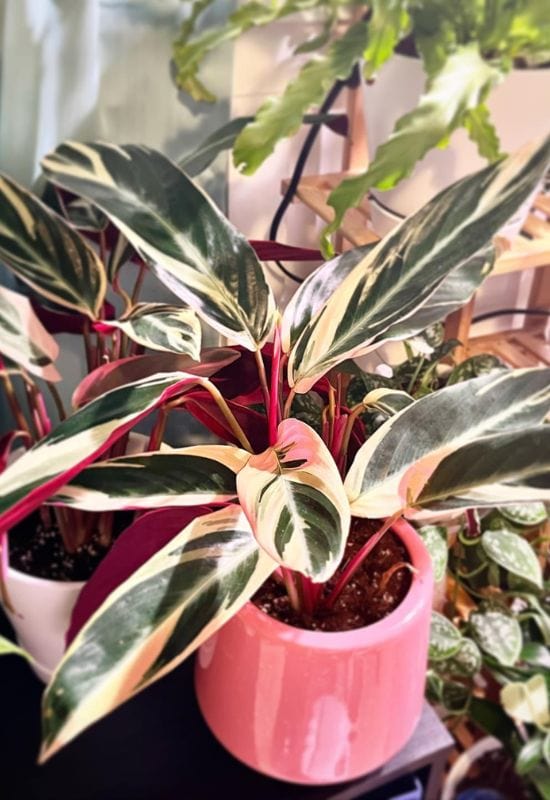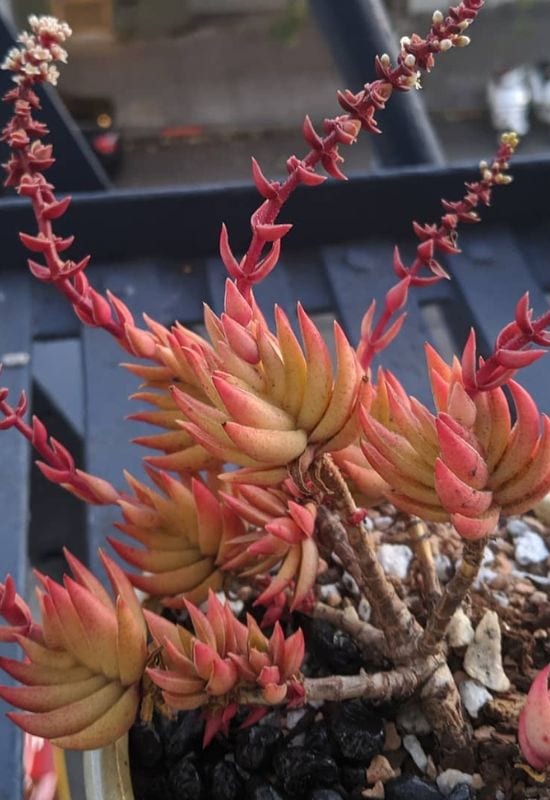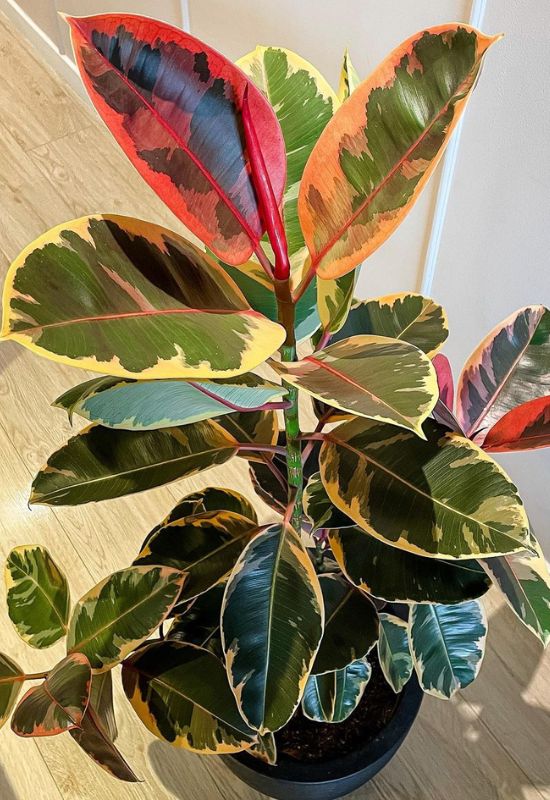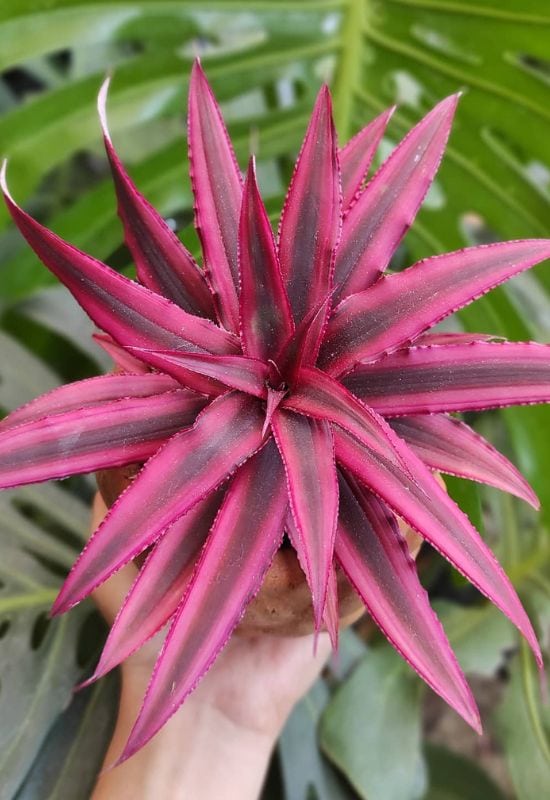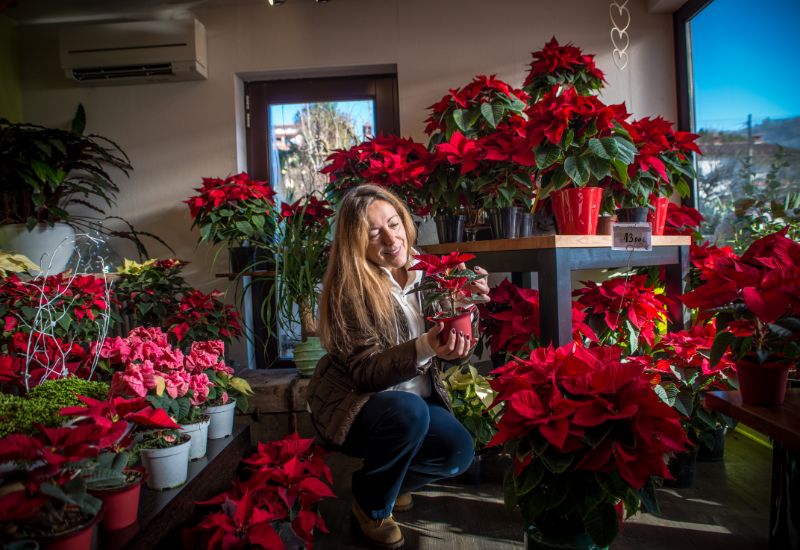
Lush green foliage indoors gives you a great sense of peace, maybe even of living in the shade of a tropical garden… But red leaves! Yes, if you want warmth, energy, even a sense of passion, you need a houseplant with vibrant colors! And when it comes to leafy varieties with intense scarlet, crimson, ruby, cherry, or burgundy, there is no match!
In fact, we mainly love houseplants for their foliage (true, for their flowers as well); we pick them because they are glossy, because they are large, or because they have amazing shapes. But don’t forget color! Pick a indoor plant variety with leaves in tonalities of red, and even the dullest room will flame up with light!
Unleash your inner plant parent and inject some excitement into your home décor with these 20 red-leafed houseplants. From bold crimson to sultry ruby hues, these stunners will add a captivating pop of color and warmth to any room.
Whether you’re looking to liven up your living room, energize your office space, or add some spice to your kitchen, these vibrant plants with their amazing red hues and variegation are just what you need to ignite your soul.
Browse our collection of exquisite red-leafed indoor plants below and let your heart guide you in finding the perfect one that resonates with you. Don’t settle for anything less than a plant that truly complements your personal style.
So go ahead, take a look, and get ready to be captivated by these stunning additions to your indoor garden.
20 Houseplant Varieties with Striking Leaves as Red as Fire, Love, or Blood
Yes, because red is the color of love, fire and blood, powerful, intense and with many shades! Behold the beauty of houseplants boasting striking red foliage, featuring a range of shades from ruby to crimson, with many boasting variegated patterns for added visual interest..
And these red leafed indoor plants are ready to light a flame in your heart, so, no need to keep them waiting: shall we start with a classic? Off we go!
Let’s Transform your home into a colorful oasis with these 20 houseplants boasting vibrant red leaves, perfect for adding a bold pop of color to your indoor garden.
1: Poinsettia (Euphorbia pulcherrima)
There is no better houseplant to start with if we are talking about red leaves: poinsettia! Maybe because its color is the reddest of reds, the brightest, the strongest, in perfect rich scarlet, or may be because it is so popular that it’s become a symbol of the festive season, and in fact, it is also called “Christmas star”!
The top leaves are the colorful ones, as we know, and there are varieties in crimson, pink and white as well, in many shades and variegated too… In all, we count about 100 cultivars!
Forming a dense bush with pointed foliage, corrugated in texture, this will be deep green at the base, and change totally at the top… Why this, you may wonder?
They are actually bracts, and if you look closely, you will find the tiny yellow flowers at the center, which blossom in winter. Because they are small, thus shrub (or even a small tree in Nature), has found another way of attracting pollinators.
Native of Mexico and South America, it has become a very important houseplant commercially, and millions are sold every year (70 in the USA alone!), but few survive the winter holidays…
While its Latin name, pulcherrima, means “very beautiful”, it has a hidden dark side: it contains an irritant, but it is not toxic, nor dangerous. On the contrary, it is being studied to treat Alzheimer’s.
We all love to have poinsettia as a flaming red Christmas star for the festivities, but then? There is no reason to throw it away; with good feeding and pruning, it will come back with its bright leaves again and again. And you can even give it some fresh air in your garden in summer.
2: ‘Imperial Red’ Philodendron (Philodendron erubescens ‘Imperial Red’)
And we move to another classic of indoor gardening: an impressive philodendron cultivar called ‘Imperial Red’… This amazing houseplant adds something to the super glossy, broad but lanceolate leaves, leathery and with lovely, regular veining… Yes, they will unfold on strong and thick petioles, and each can reach 16 inches in length (45 cm)!
So, it is quite spectacular in with the shape, size and texture… But wait – we are looking for color! And indeed, the foliage mixes amazing shades that range from bright green to deep and dark red!
And in the middle, you will be amazed to see what combinations these two tonalities make, including copper, bronze and sometimes even hues on the orange range… Growing up and then fanning out, these amazing leaves will hold a surprise for you…
In late spring or early summer, you may see a big, dark ruby red spathe rise from the soil, and when it opens, you will also notice a a long white spathe inside!
‘Imperial Red’ has become a very popular houseplant all over the world since its introduction as a hybrid cultivar in 1980. Its colorful display and many shades of red make it a warm and intense presence in any indoor space!
3: ‘Trusty Rusty’ Coleus (Solenostemon ‘Trusty Rusty’)
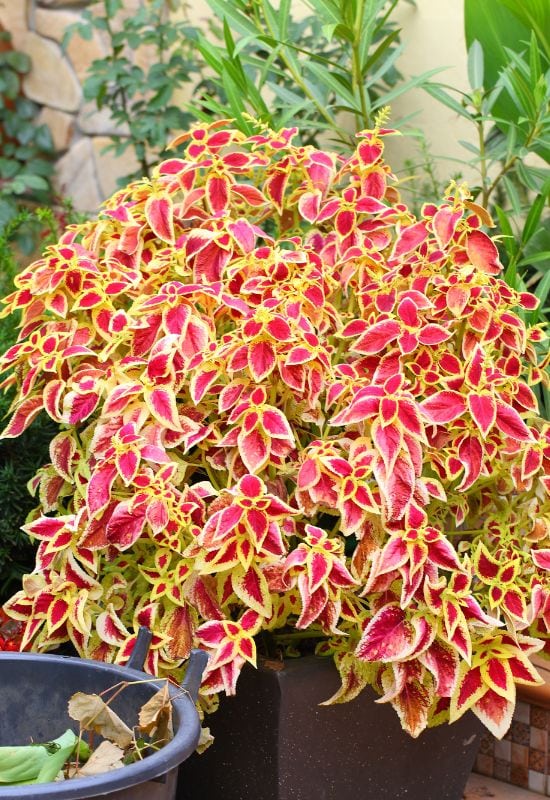
Coleus is the prince of colors when it comes to houseplants, and garden varieties too. And we are going to meet one with amazing tonalities, sweetly called ‘Trusty Rusty’. And it is very true to its name…
The leaves have the typical pointed shape with serrated edges, arranged as they are to form little crosses around the stems… Most of the foliage is, you may have guessed of a very refined, brilliant rust red color, very hard to achieve indeed.
However, the shape is then enhanced by a the golden mustard yellow that you find all around the edges! Dramatic and heat tolerant, this unique chromatic combination has not passed unnoticed by the Royal Horticultural Society, which has awarded it the famous Award of Garden Merit!
Little spikes of flowers, delicate and small but pretty, any time from spring to fall. But this means that the plant is about to end its life.
Popular in outdoor gardens, ‘Trusty Rusty’ coleus is also an easy to grow and playful little houseplant that can bring its unique red tonality even to small places, like window sills, shelves, coffee tables etc…
4: Polka Dot Begonia (Begonia maculata)
Native of Brazil, polka dot is an incredibly elegant species of begonia! This is mainly due to its long and pointed, leaves, which can reach 12 inches in length (30 cm) and they hang beautifully, nodding on strong petioles, like floppy ears, or curtains…
Its binomial name comes from the fact that they have white spots on them, quite visible, and they almost glisten in the right light, and this is also due to the glossy surface…
The under pages will be purplish or red, and you can see this quite well, thanks to their positioning… The upper page, instead, is green, always rich and mid to very dark, but…
With plenty of sunlight, the tops too will take on copper, orange and finally red tonalities too! All this is then heightened by its upright habit, that makes it look very smart indeed!
The effect is striking all year round, and this is then enhanced by the clusters of elegant, white or pink flowers that blossom all the way from spring to fall!
A very much loved and popular houseplant with amazing leaves and foliage color, polka dot begonia has red un many shades, but also many other colors too, and it can make any room look like a corner of the rainforests it comes from.
5: ‘Noble Red’ Echeveria (Echeveria ‘Noble Red’)
Are you looking for a classic succulent to grow as a houseplant? Do you want it to have red shades as well? Then ‘Noble Red’ echeveria is your man! Or plant, actually… Like all other varieties in this genus, thus cultivar forms lovely, artistic and even sculptural rosettes with its pointed but plump leaves…
But it has the habit of blushing… And in fact, it can even reach very dark ruby tonalities, but you will need to give it plenty of light… It will also tend to have yellowish to greenish and even orangish hues on new and young foliage, but then…
Starting at the tips, the d pigments will start to develop, getting more and mor intense, and touching notes of cherry, and then tend to its deeper range.
It is also a flowering plant, of course… But at very odd times indeed; unpredictably, it will produce stems that rise up and produce bright carmine red blooms!
To have the best results with the red tonality of your ‘Noble Red’ echeveria, it will need plenty of light but also fairly cool temperatures. Warmth and darkness will make it produce more green. So, maybe the best place for it is by a well lit window in your kitchen or even bathroom.
6: ‘Mammy Red’ Croton (Codiaeum variegatum ‘Mammy Red’)
Croton is the king of houseplants with variegated foliage… With a range of colors to impress, it has been an indoor favorite for many decades, and one variety, ‘Mammy Red’ brings out the red tonalities better than most…
To start with, it will give you big and broad, super leathery and super glossy leaves with fairly irregular shapes and a very unique thickness, as if they were made of rubber, almost…
And now let’s talk about its palette… You will see so e green, even rich, yellows of many types that blush to oranges… And then, of course, many tonalities of red, from bright and fiery scarlet to carmine and then cherry, ruby…
All the possible variations you can imagine… And, in fact, these warm shades will darken to purple, even very dark indeed! What is more, small yellow flowers may appear in clusters at the tips of this amazing plant, not massive, but pretty, and usually in spring or summer, but this can happen at any time of the year.
One of the best houseplant varieties to spice up any indoor space with its overwhelming color display, ‘Mammy Red’ croton is also very easy to grow, and it will tolerate different lighting conditions, so you can have it in many places. However, for best coloring you will need bright light.
7: Bloodleaf (Iresine Herbstii)
Well, I suppose the name of this perennial from South America says it all… In fact, it comes from the amazingly powerful, energetic and eye catching coloring of its foliage…
On it, you will see a range of reds that is very impressive indeed: veining and patches follow patterns in bright shades of crimson, cherry, ruby, sometimes even scarlet, and then they also blush to dark burgundy and purplish.
But if you look closely at the densely packed pointed leaves, you will see greenish undertones emerge from beneath, as if hidden, or used for light and darkness effects, or to mix the palette for more precise and rare tonalities.
And all this is greatly enhanced by the glossy surface they have… Then, between late summer and early fall, tall stems will emerge from this glowing and burning display, bearing clusters of small whitish flowers that add a contrasting effect. No wonder it has received the Award of Garden Merit by the Royal Horticultural Society!
Quite common as a garden variety, bloodleaf will only grow in hot climates outdoors. On the other hand, if you grow it indoors, it will bring the heat of its native places inside: it’s like having a sparkling living fire in your sitting room…
8: ‘Inca Flame’ Begonia (Begonia rex ‘Inca Flame’)
So, we can meet another begonia variety with a very suggestive name: ‘Inca Flame’! You won’t believe your eyes! It has very large, broad, sometimes almost heart and sometimes irregularly shaped and – above all – incredibly glossy leaves!
It looks like they have been polished or that they shine with a light of their own. The surface is almost in 3D, with very sinuous relief patterns that add to the overall effect…
And, of course, they have deep shades of crimson to wine, with hints of ruby and a touch of burgundy sometimes! However, at times it also develops tonalities of scarlet and even carmine!
So, if you were looking for a fully red houseplant with an amazing chromatic range, you have found it. Not big in size and slow growing, it can really add an amazing splash of color to a whole room anyway!
And of course, it is also a flowering perennial… Even if it is not a keen bloomer, delicate looking pale pink flowers with soft petals may appear in clusters at the tips, from summer to fall.
‘Inca Flame’ begonia is by far one of the best houseplants you can have if you need lots of energy, warmth and passionate depth to indoor spaces, on a table, or even a shelf, given its modest size.
9: ‘Red Star’ Cabbage Tree (Cordyline australis ‘Red Star’)
For a tropical island look in an indoor space, a palm like tree is what you can’t do without… But maybe you don’t want it green, but more alight with warmth and bright colors… And ‘Red Star’ cabbage tree will definitely come to help you!
It is not actually a real palm, but it looks like one, thanks to the dense rosettes of blade like and fleshy leaves, which look hard and sharp at the same time, it forms at the tips of the branches…
And this variety in particular is super glossy, and you can see the light passing through them. And in fact, don’t miss out on this effect! Because you will see thin and elegant lengthways stripes of red in shades of crimson and similar tonalities.
But you will also spot pink and rose, some orange, even a few hints of greenish and, above all, deep violet purple, especially in the central lines! Each leaf can be about 28 inches long (70 cm), which is impressive, but wait!
Yes, wait till late spring and you will see massive panicles of cream white flowers, that can reach 40 inches in length (1 meter)!
True, this is more frequent in open gardens, but possible indoors as well. And… there’s a final touch… These amazing floral displays are also wonderfully fragrant!
You will need a big room to house ‘Red Star’ cabbage tree, but if you do have it, it will literally light it up with its exotic variegated and red foliage, and fill it with bountiful and beautiful, and super sweetly scented blooms!
10: ‘Red Flash’ Angel Wings (Caladium bicolor ‘Red Flash’)
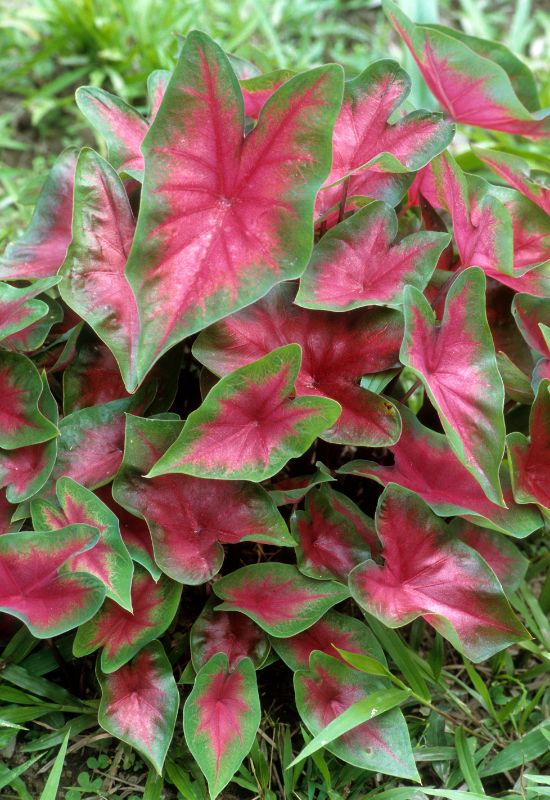
Still in a very tropical and exotic mood, but with a touch of fiery passion, we meet ‘Red Flash’ angel wings, a popular houseplant with lots to offer… To start with, it produces some of the largest foliage of this tuberous perennial from Latin America, reaching 12 inches in length (30 cm).
Also called “heart of Jesus”, because the leaves look like massive hearts, this particular variety has a massive scarlet red patch in the middle, which starts of as in a spider like shape, and then it slowly takes over most of the surface.
Ideal lighting is necessary to get the best and most vibrant tonality, otherwise it mag tend to rose or magenta. This energetic display is perfectly set off by the margins, which are bright green, on the emerald range – and by the glossiness of this plant.
It will rarely blossom indoors, but if it does… A large and elegant white spathe will emerge from the soil and open slowly to display the central spadix, which is cream… You can encourage its blossoming by moving it outdoors for the warm season.
While ‘Red Flash’ angel wings likes shady conditions outdoors, it will require plenty of light indoors, but also lots of warmth and humidity. If you can offer these conditions to your houseplants, then you too can enjoy the dramatic spectacle of “heart of Jesus” at home or in your office!
11: ‘Red Emperor’ Chinese Evergreen (Aglaonema ‘Red Emperor’)
Native of Thailand, Indonesia and Malaysia, the genus Aglaonema offers us a few varieties with red for your indoor spaces, for example, the romantic ‘Valentine’ or the popular ‘Siam Aurora’.
But if you want lots of this color, maybe the best is aptly called ‘Red Emperor’… In fact, its broad and pointed elliptic leaves are almost totally red, with a bright tonality that may vary crimson to scarlet, according to lighting.
Do wipe it clean regularly, though, because this will enhance the shiny effect you get from the glossy surface. However, the margins have a small line of bright green running along them. This way, the bold shape of the foliage is set off and outlined perfectly well.
And one fay, from the center of this leafy beauty, you may see a beautiful green or white spathe rise in all its majesty, and open slowly to reveal a large and thick white spadix inside! You need to treat it well to encourage this show, but it is known to blossom in enclosed spaces quite well!
‘Red Emperor’ is a stunning and dramatic looking houseplant with lots of energy, and it will also bring good luck to your living room or office, but do give it an important place, like on a desk or as a centerpiece on a table.
12: ‘Red’ Nerve Plant (Fittoniaalbivenis‘Red’)
Nerve plants are some of the most colorful little perennials we can get from a continent that really understands colors, in culture and with its Nature: South America. And there are a few in love and fiery tints, but one, simply called ‘Red’ (also ‘Minima Red’) excels them all…
Forming small but very leafy and dense mounds, this variety displays the telltale sign of this genus, broad, glossy leaves with an amazing pattern on them, like nerves in our body (hence the name) or, more on theme, the blood system with bright veins…
But in this case, the actual red takes over and pushes the deep green shades to the sides. This happens over time, so, new and old foliage looks different. A similar one, but with clearer veining and more green is ‘Ruby Red’…
Given the contrasting patterns that these little gems offer, people usually like to mix and match many varieties and cultivars, but that’s up to you… It is also a flowering plant, but the spikes of whitish or pink blooms are small and inconspicuous – not their main asset.
One of the most playful perennials with red leaves, ‘Red’ and ‘Ruby Red’ will suit a bookshelf, a small space but also less formal indoor spaces, like kitchens and even bathrooms. One thing is sure: children really love them!
13: ‘Luna Red’ Rubber Plant (Peperomia caperata ‘Luna Red)
But how about if you are looking for deeper, darker, more dramatic shades of red in your houseplant? Have a look at ‘Luna Red rubber plant (sometimes called ‘Schumi Red’), then… This Peperomia variety has an amazing coloring indeed, with impressive tonalities along the wine, burgundy and raspberry range!
As it darkens, it will hit notes of purple too, but the effect has another helper… The fleshy leaves in shapes that range from cordate (heart shaped) to ovate form a very dense mound with a draping habit, and sometimes they fold up at the margins as if to form spoons or ladles…
But this is not all… The surface of the foliage is extremely glossy and bumpy as well… Rather than normal leaves, they look like works of art in relief, forming interesting patterns as well as lots of games of light!
This adds to the intriguing mix of its exceptional palette! Very unusual flowers will rise above this little moody and leafy clump white, tall and long, and arching at the tips… They look like periscopes peeping out of a sea of blood, or, for some people, rat’s tails…
‘Luna Red’ rubber plant is a very unusual houseplant with deep red to purple leaves, and it is particularly suitable to hanging baskets or deep containers; it is the variety you want for an alien looking element in a creative room…
14: ‘Tricolor’ Dragon Tree (Dracaena marginata ‘Tricolor’)
For another palm like houseplant with red in its palette, a very popular and easy to find one is ‘Tricolor’ dragon tree… As the name suggests, it has more than one color though… In fact, red tonalities will develop mainly at the margins of the long and thin, pointed and grass blade like leaves.
Its exact tonality will depend a lot on lighting, ranging from crimson to scarlet, from paler to darker, and it also depends on the age of the foliage… But you will also enjoy stripes of green and cream, again varying in exact shade, that give the whole a very elegant and at the same time kaleidoscopic effect!
These will form a very airy, light and slim looking tuft, a rosette, at the top of the trunk or branches… Winner of the Award of Garden Merit by the Royal Horticultural Society, this Madagascar native can also produce clusters of fragrant white flowers in spring, which are then followed by orange yellow berries. However, this rarely happens if you grow it as an indoor plant.
Foe an elegant room that needs a touch of graceful elegance, color and also an exotic looking houseplant, ‘Tricolor’ dragon tree is a perfect variety to choose, and an easy one to grow as well!
15: Ti Plant (Cordyline fruticosa)
An Asian native, Ti plant has an important and deep role in the many ancient cultures of that beautiful continent, from religious to culinary… But it has also become a much loved houseplant, and it can offer you the color you have been looking for.
Its big and exotic looking leaves, glossy to the point of shining, elegantly arching, can reach 2 feet in length (60 cm).
They will display great shades of green, bright to emerald, but they blush as well, and some varieties are naturally purple or red, and this is especially true of those coming from Buton Island in Indonesia.
Now, thanks to selection, you can find many cultivars that display tonalities from magenta to crimson and then darken to ruby and even purple, like with ‘Red Sister’.
With a shape and a habit that remind you of a mix between a banana or another leafy species from a tropical forest, and at times a lush palm, it is a really exotic presence indeed!
It is also a flowering and fruiting plant in the wild, or outdoors, but rarely indoors… If it does, amazing straight and erect panicles of white to pink and scented panicles will emerge, and then turn into glossy red berries.
Loved all over the world in tropical and Mediterranean gardens, Ti plant can only grow indoors in mild and cold climates. On the plus side, it will make your living room or office look like a hidden corner in a rain forest, only with a strange, red light coming through…
16: Never-Never Plant (Stromanthesanguinea)
Coming Latin America, never-never plant also has a Latin word in its name that gives away its coloring: sanguinea, which means “of blood, related to blood”. Two cultivars in particular will give you what you are looking for: “Tricolor” and “Triostar”.
Looking at language again, these terms refer to the variegation of the leaves, where you can find deep, dark green, cream white and, of course shades of red that range from rosy crimson to purplish.
Coming in elegant, diagonal and irregular stripes that start from the midrib and lead to the smooth margins, these can vary a lot from leaf to leaf, and from plant to plant – always a pleasant surprise though.
The effect is very lively and artistic, and the under pages reinforce the red range, as they are always purplish in color, as are the petioles… Very glossy and smooth, like marble, the lanceolate foliage points up, or out, giving you a rebellious and energetic tropical clump, also because they keep opening and closing during the day!
However, the scientific name of this exotic rhizomatous perennial refers to the bracts that showcase the small white flowers, which are bright scarlet in tonality! Unfortunately, these fiery clusters are a rare sight, especially indoors…
Both sculptural and colorful, never-never plant is a very luxurious presence for bright rooms, where you want to throw the cards in the air and see what Nature brings to your indoor spaces, and the puzzling patterns are always very showy and eye catching.
17: ‘Red Pagoda’ Crassula (Crassula capitella ‘Red Pagoda’)
Imagine having a little and elaborate sculpture on your coffee table… No need to spend a fortune on it! You can be original and grow ‘Red Pagoda’ crassula! In fact, its foliage is so geometric, so regular, so well structured, that it forms patterns and shapes like origami, thanks to its regularly arranged triangular leaves that grow on the hidden stems, like pagodas, in fact!
And on the succulent foliage you will see green, especially on new shoots, but then it will blush to shades of red from crimson and scarlet all the way to ruby and burgundy… Blue and grayish too will appear, and sometimes even yellowish, and violet…
This all depends in lighting and even the seasons… As it matures and ages, it will become bigger and spread, forming structures that will look like a whole village in Japan… And this “small settlement” will flare up with plumes of small white flowers too, rising above the roofs with purplish stems!
Playful and artistic at the same time, ‘Red Pagoda’ crassula comes from South Africa to decorate your tables, shelves and even garden if you wish, but it will require very little care – and it will always be the focus of attention.
18: Red Vase Plant (Guzmanialingulata)
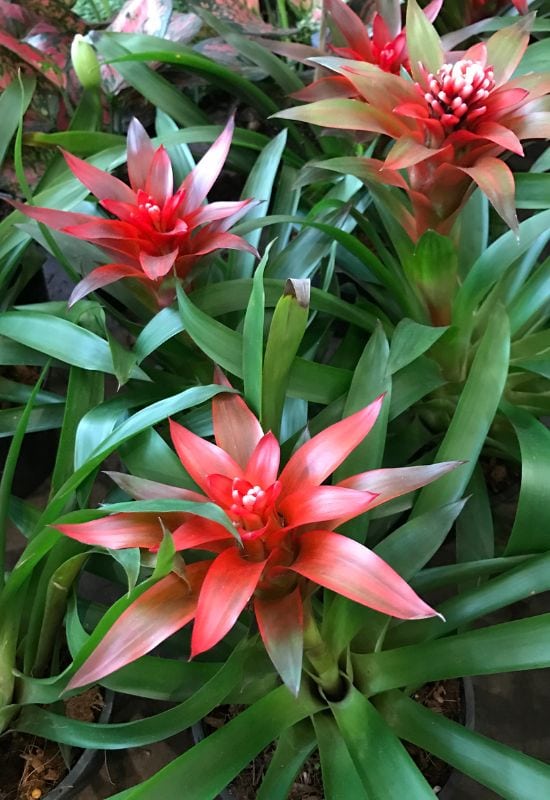
We come to a native perennial from Central and South America that will confuse you, though it is very popular… Yes, because you will think that red vase plant (Guzmanialingulata) has a massive red flower at the top… But you would be wrong!
Look closely and you will notice that its super glossy, long and arching leaves form beautiful rosettes of emerald shades at the base… And the bloom will look exactly like them, coming out of them, and in a way, completing them…
That’s because they are leaves too, but what is different is the amazing color: red! You can actually have them in various tonalities, from scarlet to cherry, then ruby and even maroon. You can also easily get a cultivar in yellow or orange, or even pink… Well, if you like colors, you can have as many as you wish.
But how about the flowers then? They will appear at the very end of this fiery but leafy display, at the very, very top… And they re small, whitish and in a little cluster…
One of the most popular bromeliads in the world, it will end its life at the end of the blossom, but you can propagate it with the pups that will shoot off at its base.
Having said this, red vase plant (or in other colors), is very cheap and easy to find indeed! You can easily find it even in supermarkets and generic stores…
Unlike other houseplants, it will give you its red colors even in low light conditions, and that’s why many people like to have them in corridors and corners with dull lighting.
19: ‘Ruby’ Rubber Fig Tree (Ficus elastica ‘Ruby’)
We now meet a blushing and flaring cultivar of a very much loved houseplant: ‘Ruby Rubber Fig Tree’! So called because its large, ovate leaves, that can reach 12 inches long (30 cm), have an amazing texture, which looks and feels like rubber, it is usually deep green…
But this particular child of the Ficus genus is special… While the under pages are typically reddish purple, the wonder appears on the super glossy upper sides of the foliage… There you will meet a mix of shades that range from cream white to dark violet purple, and in the middle, you will also see it take on greens of all sorts, as well as reds of all sorts!
Expect the range between pink and crimson, of course. And this will darken to ruby, plum, raspberry and finally purple. But with the right light, you will also enjoy the orange to carmine palette, which includes tonalities of scarlet and apple!
Growing into a small tree, this kaleidoscopic and evergreen (or ever colorful) daughter of an Asian native, is a spectacle all year round!
The perfect houseplant to lift up a whole big room, ‘Ruby’ rubber fig tree is quite easy to grow, and while in Nature it can grow to 131 feet (40 meters!), it will keep under your ceiling indoors, and it will fill it with its amazing colors, including in the red range.
20: Red Star Bromeliad (Cryptanthus Bivittatus red star)
We finally come to a heavenly houseplant, though, I am not sure this is the right description… Native of Brazil, Cryptanthus bivatticus is called “earth stars” because it forms amazing rosettes that keep close to the ground…
It usually comes in green or or variegated varieties, sometimes looking like snakes crawling, sometimes like a creature from outer space… Our particular cultivar, ‘Red Star’ will remind you of an oddly colored inhabitant of the deep ocean…
Like a starfish, or even an octopus… The long and pointed leaves that arch beautifully have wavy edges, as if moved by the currents of the see… But what is exceptional about this variety is also the rosy crimson color you will see on these “arms”…
It can even blush to darker tonalities, including purplish, especially in the middle, where there’s a darker broad stripe. But one of the notes it hits quite frequently is that of the most famous red jewel of all: rubies!
One day, in the middle of the rosette, you will also see a cluster of pale and and bright greenish yellowish flowers appear. That, unfortunately, means that it will soon die (or go to heaven, in this case). But don’t worry, offsets will grow up at its base, so you can propagate it!
Yet another member of the Bromeliaceae family, ‘Red Stars’ earth stars is a very eye catching houseplant with red foliage… Small but very sinuously sculptural and bright in color, it can become a light filled centerpiece in an office or big living space.
Not One, But Many Red Stars for Your Indoor Spaces!
If we closed with a red star, you must admit that all these houseplants deserve the status of stardom, with their beautiful leaves in many shapes, textures, and shades of red!

Written By
Amber Noyes
Amber Noyes was born and raised in a suburban California town, San Mateo. She holds a master’s degree in horticulture from the University of California as well as a BS in Biology from the University of San Francisco. With experience working on an organic farm, water conservation research, farmers’ markets, and plant nursery, she understands what makes plants thrive and how we can better understand the connection between microclimate and plant health. When she’s not on the land, Amber loves informing people of new ideas/things related to gardening, especially organic gardening, houseplants, and growing plants in a small space.

